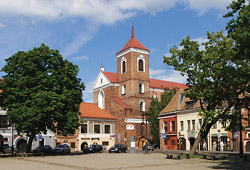Basilica
Construction of the Kaunas Cathedral took place in stages, starting in the 15th century and ending in the 20th. Its architecture includes both gothic and renaissance traits. From the outside, the rectangular three-nave Basilica is an impressive bare brick structure with a massive tower rising to a height of 41.9 meters (137 feet). The external structural design features large, simple shapes distributed asymmetrically, among which the white-plastered cornices and ledges stand out, as do the arch windows and buttresses. The Chapel of the Blessed Sacrament, built in the late 19th century in an extension of the southern nave, is like a tiny church in its own right, nestled up against the immense Cathedral.
The current interior of the Basilica involves multiple layers, installed over a period of three and a half centuries. Stylistically, the gothic and baroque layers clearly stand out from each other, though there are also later strata. Only the presbytery and the sacristy maintain truly gothic spaces and forms. Of special value is the webbed semi-dome of the presbytery
The painted scenes and ornamental polychrome that decorate the vaults and walls of the sanctuary all date to the end of the 19th century. The themes of the painted scenes are linked with the central themes of the main altar – the Crucifixion and events in the lives of the Apostles St Peter and St Paul. Altogether there are 9 altars in the Cathedral.
The current main altar, dedicated to the Crucified Jesus, was blessed in 1775. The main accent is Christ on the Cross which rises up in a niche above the altar. At the foot of the Cross, St Mary Magdalene kneels. The skyline of Jerusalem is painted on the surface of the niche, which is framed on either side by numerous columns and, among the columns, statues of Mary and the Apostles. At the centre of the second vertical space stands a statue of the Risen Christ. Genuflecting on the left is St Peter with the keys, and on the right, St Paul with the sword. Sculptures of the Evangelists holding books are on ledges that jut out over the columns below. Ledges over the side columns bear statues of St Gregory the Great, on the left, and St Augustine, on the right. The main altar is crowned by an enormous representation of the Divine Glory, in which one can see God the Father with wide open, welcoming arms. Just below that in the same space, the Holy Spirit is represented as a dove. Thus, the Most Holy Trinity emerges from among the vertically arranged figures.
The 17th century Altar of the Assumption of the Blessed Virgin Mary into Heaven, at the end of the left nave, is the only altar in the Cathedral which has preserved its original appearance. Its architecture, painting, sculpture and woodwork form a harmonious unity that is based on a complex iconographic plan. The first level of the altarpiece is dedicated to Holy Mary’s Assumption, the second to her Coronation. Both images were painted in 1686 by Johann Gothard Berghoff. The altar’s main painting is enclosed in an elaborate double frame of blue carved wood. The relief in the wider band of the frame portrays bearded kings holding sceptres at the centre of flower blossoms. They represent the Davidic ancestors of Mary and Joseph, the so-called Jesse Tree. A small image of the Mother of God and Child crowns the composition.
In 1895, the Chapel of the Blessed Sacrament was constructed by the southern wall of the presbytery. It is completely independent, with carved-wood furnishings in the neo-gothic style – altars, an organ loft, a confessional and pews – that suit the chapel’s architecture very well. The altar with paintings and sculptures is dedicated to St John the Baptist, a patron saint of the diocese. At the centre of the altarpiece is a painting of the Baptism of Jesus. A representation of St Casimir is on one side and St Stanislaus on the other. Cardinal Vincentas Sladkevičius is buried in the Blessed Sacrament Chapel, in a tomb covered with a slate of white marble.








